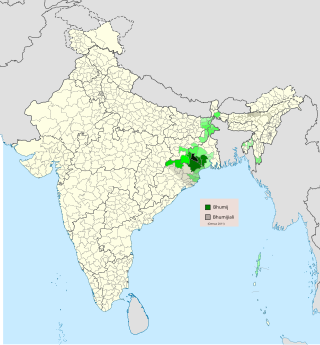
Sword dances are recorded throughout world history. There are various traditions of solo and mock-battle (Pyrrhic) sword dances from Africa, Asia and Europe.

The Munda people are an Austroasiatic-speaking ethnic group of the Indian subcontinent. They predominantly speak the Mundari language as their native language, which belongs to the Munda subgroup of Austroasiatic languages. The Munda are found mainly concentrated in the south and East Chhotanagpur Plateau region of Jharkhand, Odisha and West Bengal. The Munda also reside in adjacent areas of Madhya Pradesh as well as in portions of Bangladesh, Nepal, and the state of Tripura. They are one of India's largest scheduled tribes. Munda people in Tripura are also known as Mura.

The Kharia are an Austroasiatic tribal ethnic group from east-central India. They originally speak the Kharia language, which belong to Austroasiatic languages. They are sub-divided into three groups known as the Hill Kharia, Delki Kharia and the Dudh Kharia. Amongst them, the Dudh Kharia is the most educated community.

Chhau dance, also spelled Chhou dance, is a semi classical Indian dance with martial and folk traditions. It is found in three styles named after the location where they are performed, i.e. the Mayurbhanj Chhau of Odisha, the Seraikella Chhau of Jharkhand, and the Purulia Chhau of West Bengal.
The tribes of Jharkhand consist of 32 scheduled tribes inhabiting the Jharkhand state in India. In 1872, only 18 tribes were counted among the schedule tribes from which Banjara, Bhatudi, Chik Baraik and Mahli were marked as semi-Hindu aboriginal and Kora as proletariat Hindu. In the 1931 census, including above four semi-Hindu aboriginal and Kora, a proletariat Hindu, the number was raised to 26 from 18 by adding four more in the annexure. They were Birajia, Godait, Karmali and Paharia, but Kisan was excluded from the list. In 1941 census, Baga, Bedia and Lohra included again taking Kisan in the annexure and number came to 30 which was prevailing till June 2003. Kanwar and Kol were added on 8 June 2003 in the annexure and the number of Schedule Tribes came to 32.
Paiki is a Sadani Nagpuri martial folk dance of the Chotanagpur plateau region of Jharkhand, Chhattisgarh and Odisha. In the dance, people wear dhoti, a turban with peacock feathers in it. They hold sword in their right hand, a shield in their left hand and dance to the tune of musical instruments of Nagara, Dhak, Shehnai and Narsingh. It is done by men and reflect valour. It is performed at weddings and functions. Paik were foot soldiers during medieval period. It is primarily performed by Rautia, who used to be soldiers during reign of Nagvanshi dynasty in Chotanagpur. It is also performed by some Munda tribe in Khunti and Mayurbhanj district.

Bhumij is a Munda ethnic group of India. They primarily live in the Indian states of West Bengal, Odisha, and Jharkhand, mostly in the old Singhbhum district. Also in states like Bihar and Assam. There is also a sizeable population found in Bangladesh. Bhumijas speak the Bhumij language, an Austroasiatic language, and use Ol Onal script for writing.

Chuar rebellion, also known as Jungle Mahal movement was a series of peasant movements between 1766 and 1816 by the tribal inhabitants of the countryside surrounding the Jungle Mahals settlements of Midnapore, Bankura and Manbhum against the rule of the East India Company (EIC). This was the first revolt against the East India Company (EIC) in Chotanagpur areas of Bengal Presidency.

Bhumij is an Austroasiatic language belonging to the Munda subfamily, related to Ho, Mundari, and Santali, primarily spoken by Bhumij peoples in the Indian states Jharkhand, Odisha and West Bengal. As per the 2011 census, only 27,506 people out of 9,11,349 Bhumij people spoke Bhumij as their mother tongue, as most Bhumijas have shifted to one of the regional dominant languages. Thus the language is considered an extremely endangered language.

The Kudmi are a community in the states of Jharkhand, West Bengal and Odisha of India. They are primarily agriculturalist.
This article is about the culture of natives of the Indian state of Jharkhand. The state of Jharkhand is located in the eastern part of the country and is known for its vivid culture, distinct paintings, traditions and festivals.
Ghasi is a caste found in Jharkhand, Chhattisgarh, Odisha and West Bengal. They are traditionally caretakers of horses and village musicians. They are known as Ghasiya in Uttar Pradesh.
The Nagpuria people, also Nagpuri or Sadan, are an Indo-Aryan speaking ethnolinguistic group who are the native speakers of the Nagpuri language and natives of the western Chota Nagpur Plateau region of Indian states of Jharkhand, Bihar, Chhattisgarh and Odisha.
Sadan are the native Indo-Aryan-speaking ethnolinguistic groups of Chota Nagpur Plateau consist of Indian state of Jharkhand and neighbouring states who speak Nagpuri, Khortha, Panchpargania and Kurmali language as their native language.

Folk dances of Jharkhand represent its vibrant culture and tradition. There are various folk dance in the state of Jharkhand which are performed during harvest season, festival and social gatherings. Some folk and tribal dances in Jharkhand are Jhumair, Mardana Jhumair, Janani Jhumair, Domkach, Lahasua, Jhumta, Fagua, Paika, Chhau, Firkal, Mundari and Santali.
Potka block is a CD block that forms an administrative division in the Dhalbhum subdivision of East Singhbhum district, in the Indian state of Jharkhand.
The Bhumij Rebellion or Bhumij Revolt, also known as Ganga Narain's Hungama was a revolt during 1832–1833 by Bhumij tribals based in the Dhalbhum and Jungle Mahal areas of the Midnapore district of the erstwhile Bengal state. It was led by Ganga Narayan Singh.
Buli Mahato was a revolutionary leader of the Bhumij Rebellion and Kol Rebellion. He was a zamindar, social leader and revolutionary struggle leader of the Kudmi community of Karadih village in Sonahatu Thana, Jharkhand. He mostly rode on horseback.









